Accidents in the house are never a joyous occasion, but when your pup pees on tile, there is a silver lining – it’s one of the easiest surfaces to clean.
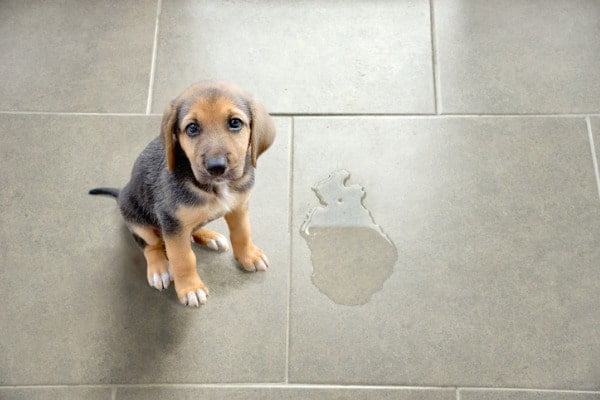
Even on tile, your first instinct might be to go for the harsh household cleaners. Bleach, ammonia or other industrial liquids do indeed serve a purpose in cleaning.
Hold that thought, though.
There are several products on the market and some already in your home that will help get the job done – without exposing you and your pup to harmful chemicals.
Here’s what we know:
In this article, I’ll go over how to clean dog urine from tile and how to clean dog urine from tile grout, all without having to resort to heavy-duty chemicals.
Don’t let these gentler solutions fool you, though. Even if they don’t seem robust, they get you going on the job better than typical cleaners.
Here’s the Scoop on Pet Urine and Tile
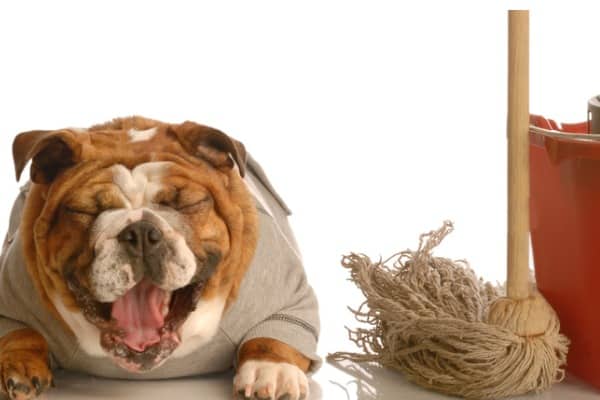
A urine puddle on a tile floor isn’t nearly as big of a hassle as it would be on a carpet or urine soaked hardwood floor.
Even your dog, should they smell like urine, is a tougher cleaning task!
That doesn’t mean you want urine to sit on your tile for any length of time – but cleanup is simpler.
What if you miss the accident?
This might happen if your dog sleeps in the bathroom or kitchen on top of a tiled floor. Maybe they leaked urine while lying down, or maybe they had an oops because they refused to go pee outside.
Whatever the case, the challenge comes in when you have to deal with getting the stain and smell out of the grout. It takes a little more work to make sure neither of those things set in the grout between tiles.
Tiles themselves aren’t as porous as carpet, fabric, or even hardwood flooring.
However, grout has more nooks and crannies where urine and ammonia can seep in.
It does take more than a bucket of soapy water to get rid of urine on grout. On recently made puddles, white distilled vinegar is usually enough to do the trick.
What if you come home to a puddle that’s been there for hours?
This is when you should look into enzyme cleaners, hands down the best type of dog urine remover.
Enzyme cleaners sometimes come with a light scent, but that’s not designed to mask the odor like some pet odor sprays.
Active, natural bacteria attack and eliminate the smells at the source.
They’re also far safer than odor eliminators and cleaners that are packed with harsh chemicals.
When you have a pet in the house, safe solutions to treat stains are one of the most important features to look for in your cleaning products.
Does Ammonia work?
Ammonia-based cleaners can attack the stain or smell, of course. Ammonia tends to remind dogs of their urine smell.
A scent like that leftover on the stain can attract your dog or puppy back to the same spot and even encourage them to have another accident.
Dogs who are in potty training will have a difficult time understanding where they should pee if they can smell a pee stain inside.
Enzyme cleaners are the best option to kick the smell out for good.
Not only are enzyme cleaners natural and safe, but they’re also the most powerful weapon against urine stains.
They have enzymes that are great at killing smells at the source rather than masking them.
Follow These 3 Steps for How to Remove Dog Urine Odor from Tile Floors
Cleaning up urine from tile and tile grout requires about half the time as cleaning a urine-soaked carpet.
A few things you’ll want to have on hand include a cleaning brush, an old toothbrush, and some absorbent rags or towels.
1. Soak It Up
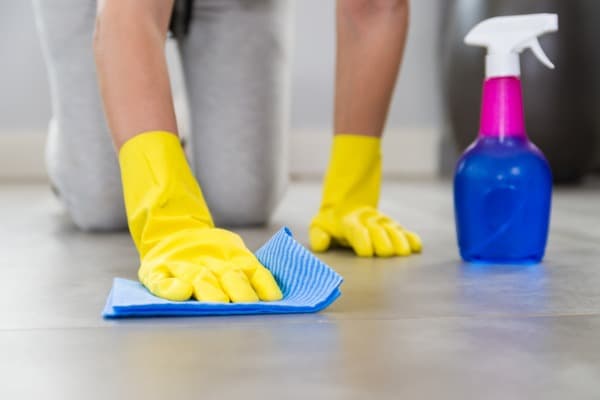
The first step is the least pleasant one – you’re going to have to mop up the excess urine with your rags or paper towels in a pinch.
I don’t recommend sponge or cloth mops unless they have a detachable head that can be disposed of or put through the washing machine.
Mops can also spread the mess to a larger area. No one is thrilled about getting down and dirty to clean up urine, but it’s easier to soak it up this way.
If you have disposable gloves, use them.
What should you do if you don’t have any?
Make sure you wash your hands thoroughly afterward and avoid direct contact with the urine.
When you have wiped up as much as possible, you can sprinkle a little baking soda on the area to absorb anything you missed.
Let it sit for a few minutes, and then vacuum it up before moving on to the cleaning phase.
2. Use Your Cleaner
If you choose to use white vinegar to do your first-pass cleaning of the stain, it works best if sprayed evenly on the stain.
Some pet parents like to dilute the vinegar with warm water and a little soap. This method works on tile, but pure vinegar is also fine to use.
No spray bottle? No problem.
You can measure how much you want to use, which will depend on the size of the spot. For average-sized puddles, a cup (8oz) is a good amount to start with.
Pour it on the area and use your cleaning brush or a rag to distribute the liquid evenly over the spot.
Let it sit for 10-15 minutes.
Now, bring on the enzyme cleaner:
One of my favorite enzyme cleaners for tile flooring is: Nature’s Miracle Stain and Odor Remover
Using Nature’s Miracle enzyme cleaner is pretty straightforward.
Nature’s Miracle offers guidelines for how much to use based on the size of the stain – for example, a 1×1 foot spot requires 4oz of enzyme cleaner to be effective.
This is quite a large stain, and you’ll probably be dealing with puddles much smaller. But you get the idea – a little goes a long way with this enzyme cleaner.
For me, I always let the enzyme cleaner sit on tile floors for no less than ten minutes before blotting it up. This is on the lower end of wait times.
The best rule?
The longer, the better. If you can let things be for an hour or more, it gives the odor-eating enzymes more time to do their magic.
Get it Out of the Grout
Regardless of the cleaner you use, the grout needs a thorough scrubbing before the job is done.
The cracks between tiles are an excellent place for urine to soak and sit in.
This is where I like to take a cleaning brush or old toothbrush and scrub those spots while the cleaner is still on the floor.
If you know the urine has penetrated the more porous grout, then your set time should definitely span hours. And better yet, overnight if you can do it.
A good tip…
When using the vinegar method, baking soda can be a nice sidekick. It helps to make a thick paste by mixing the baking soda with a little water.
Once you have your paste, you can apply it to the grout and wait for about thirty minutes.
Then scrub it with your brush. It’s best to do this after you’ve already wiped up the vinegar – the baking soda will react with it and bubble up.
The water in the paste will evaporate quickly, so you can leave it to set for another thirty minutes so you can vacuum it up.
Or, you can sweep it into a dustpan to dispose of it.
When you use your enzyme cleaner, you can use the excess cleaning liquid while you give the grout a final scrub.
If there’s not enough liquid to work into the grout, you can always give the spot a few extra sprays.
Once the grout is clean, you can wipe up the enzyme cleaner – no rinsing necessary.
A towel or rag works fine to blot up the enzyme cleaner. You can safely wash this rag with the rest of your cleaning supplies
3. Wipe It Up
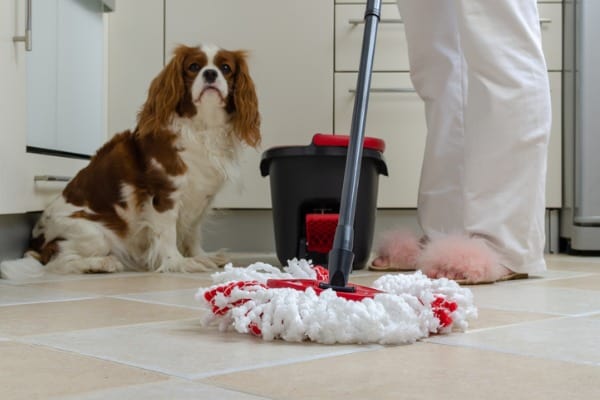
You can use rags, paper towels, or even a mop to clean up the enzyme cleaner.
I like to rinse the area with a little water one last time before allowing the spot to dry. Of course, this step is not required, so it’s up to you.
Once you have removed the cleaner, allow the area to dry. After, you can inspect it for any spots you might have overlooked and any stubborn stains in the grout.
Generally, it only takes one pass with enzyme cleaners. Old, set-in stains might need a second round of cleaning.
Preventive Advice
Avoiding accidents before they happen is best. But that’s not always possible with puppies, elderly, or incontinent dogs in the house.
One thing you can do to protect your floor is to have the grout sealed.
Sealing grout is something you can DIY or hire a professional. It’s a smart option for anyone with tile floors, and it doesn’t only protect the floor from urine stains and smells.
A protective seal on your grout can help prevent dirt, grime, mold, and other things from setting in.
It also keeps any future accidents where dog urine might seep in and reach the subfloor below. Cleaning a subfloor hit by dog urine is another project altogether!
Recommended Products
There is a wide variety of enzyme cleaners out there, and most of them do the trick.
I’m recommending some top-rated and safe brands that make a good household cleaning staple for any home.
BUBBAS Super Strength Commercial Enzyme Cleaner
This one is safe on carpets, tile, and most hardwood floors. Even delicate bamboo floors with urine spills. It goes beyond lifting just pet stains – it can even help lift stubborn spots like red wine or juice.
Use it outdoors, too. Maybe you have a neighborhood cat that likes to spray your trash can or a dog that marks their territory on lawn furniture.
This will do the trick for those issues as well.
Earth Rated Pet Stain and Odor Remover
You can purchase this unscented or with a light lavender scent. Either option works amazingly to lift urine and other organic smells from tile, among other surfaces.
It’s non-toxic and safe to use in close quarters around pets – even kennels can benefit from this product.
The high concentration of active bacteria makes it a powerful option without harsh ingredients.
Things to Keep in Mind When Cleaning Tile
Tile grout is a pain to clean – pet stains or not.
Grout in kitchens and bathrooms can be susceptible to mold and other grime that you don’t want hanging around your home.
The methods listed here are a great way to clean periodic potty accidents and keep stains from setting in.
However, just like carpets stained from pet urine, grout should be professionally cleaned from time to time and eventually replaced.
If you seal your grout, you can prolong its life by providing a barrier that keeps out dirt, liquid stains, and mold.
How often you’ll need to do, this depends largely on the amount of traffic your floors see.
FAQs about Removing Dog Pee Smell from Tile
Can Urine Soak into Tile?
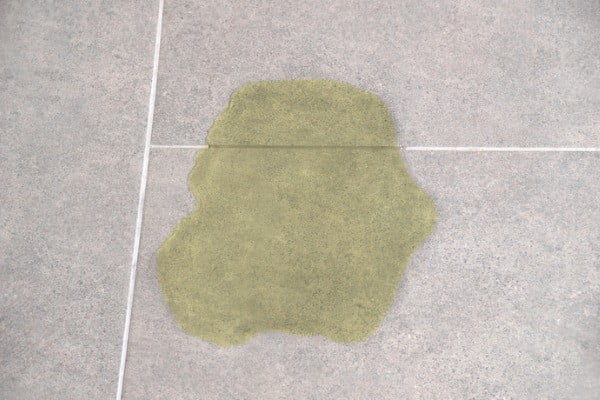
Although not as porous as wood, tile can indeed soak up enough urine to leave a stain and smell behind.
Grout is where you’ll run into the most trouble with urine setting in. This is why a simple wash with warm water isn’t enough to clean up a urine accident on tile floors.
Are Enzymes Safe to Use?
The bacteria component of enzyme cleaners can put some people off. Don’t think of it like you’re spraying a dangerous bacteria such as salmonella on your floors – it’s nothing like that.
The bacteria in enzyme cleaners are “good” bacteria – just like the good bacteria we eat in yogurt or probiotics. It will not make you ill to use it in your home.
Can Enzyme Cleaners Help Other Organic Messes?
Yes. The stains and smells left behind by vomit or feces can be eliminated by using an enzyme cleaner.
When it Comes to Pee on Tile, Enzymes Go the Extra Mile
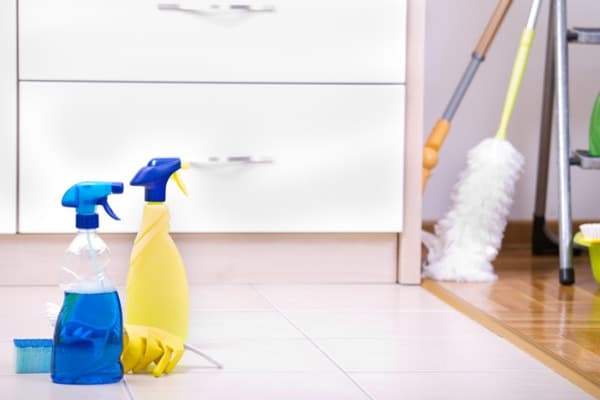
Now that you know how to clean dog urine from tile, you know that you can use a DIY or buy an enzyme cleaner. The sooner you discover the puddle, the better your DIY fix will work.
Enzyme cleaners go above and beyond in regards to getting rid of any pesky, leftover urine left behind – especially in older stains.
Tile grout is a difficult territory to navigate when you want to give stains and smells the boot. However, now you know how to clean dog urine from tile grout?
You guessed it – enzyme cleaners and some old-fashioned elbow grease.
It’s not a cause for panic when you have a urine stain on tile, and much easier to deal with than urine on fabrics.
Dealing with it quickly and thoroughly will give you the best odds of restoring your floor back to clean.

